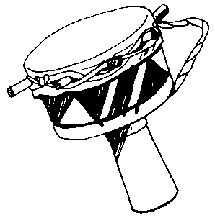Music of the Buntibe
- Details
- Created: Tuesday, 27 December 2005 18:34
In addition, there are between five and seven conical-shaped drums ranging from small hand-held ones played with sticks to a giant drum requiring one or more persons to support it in addition to the principal player. The smaller drums are covered with cowhide, the larger ones with elephant's ear.
Women play hand rattles (insaka) made from small gourds filled with seeds or condensed-milk tins and filled with small stones or seeds. Women also provide most, if not all, the singing.

Ngoma buntibe (or budima as it is called in Zambia) is intended primarily for funerals but it is also frequently played for general entertainment and on special formal occasions. In addition, ngoma buntibe groups from different neighbourhoods often meet to challenge each other at competitions (muzandano), the winning group being determined by the number of women it can attract with its singing, dancing and fanciful costumes.
The movements of the players during a bontibe are particularly interesting. It is not easy to determine why, at certain points, players break away from the main group and move off into the middle distance. Some say it is simply part of the process. However, at a funeral, all the participants revisit those areas the dead person frequented during his or her lifetime and the group continues to play whilst walking over the funeral mound under which the dead person is buried.
There is a seeming connection between warfare and ngoma buntibe. Other than the element of competition between groups, individuals (either men or women) often face away from the main group to perform kuzemba, a slow, stylised form of attacking movements which are conducted with spears, shields and knobkerries.
